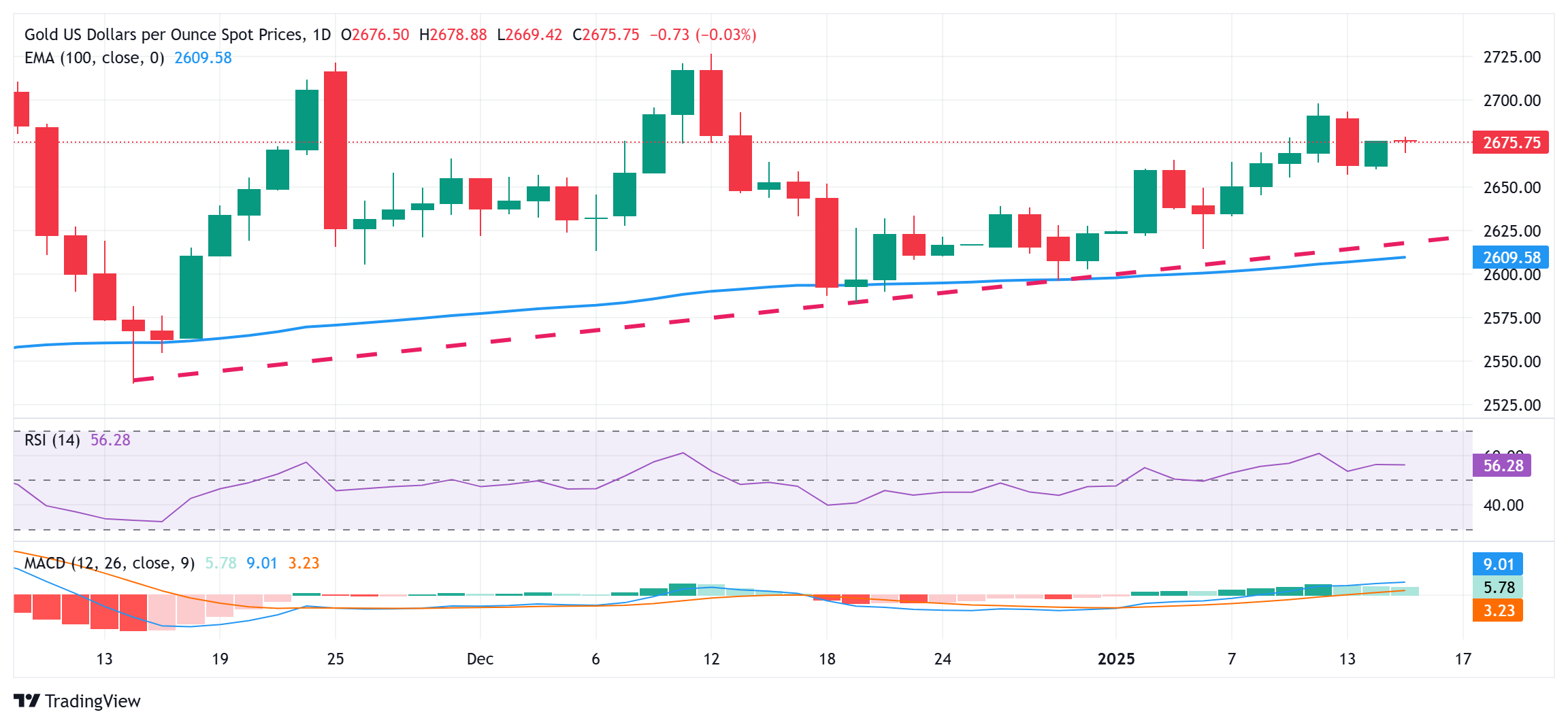Gold price bulls turn cautious ahead of US CPI; downside potential seems limited
- Gold price attracts some sellers as the risk-on mood undermines demand for safe-haven assets.
- The prospects for a slower Fed rate cut contribute to driving flows away from the XAU/USD pair.
- A softer USD and geopolitical risks could support the precious metal ahead of the US CPI report.
Gold price (XAU/USD) struggles to capitalize on the previous day's bounce from a one-week low and meets fresh supply during the Asian session on Wednesday. The global risk sentiment remains supported by easing fears about US President-elect Donald Trump's disruptive trade tariffs and gets an additional boost from Tuesday's softer-than-expected inflation data from the US. This, in turn, is seen as a key factor undermining demand for the safe-haven precious metal.
Furthermore, the upbeat US monthly jobs report released on Friday reaffirmed the Federal Reserve's (Fed) hawkish outlook and keeps the US Treasury bond yields elevated, which contributes to driving flows away from the non-yielding Gold price. The US Dollar (USD), meanwhile, struggles to attract buyers and languishes near the weekly low touched on Tuesday. This, along with geopolitical risks, should support the XAU/USD ahead of the US consumer inflation figures.
Gold price is pressured by a positive risk tone but downside remains cushioned
- A Bloomberg report, citing people familiar with the matter, said on Monday that US President-elect Donald Trump's economic advisers are considering a program to gradually increase tariffs month by month.
- Moreover, softer-than-expected inflation data from the US helped pause the recent surge in the US Treasury bond yields and boosted investors' appetite for riskier assets, undermining the safe-haven Gold price.
- The US Bureau of Labor Statistics reported on Tuesday that the Producer Price Index, which measures wholesale inflation, rose 0.2% in December and the core gauge remained flat during the reported month.
- This comes on the back of the upbeat US monthly jobs report on Friday and makes it difficult for investors to project the Federal Reserve's next moves on interest rates, which keeps the US Dollar bulls on the defensive.
- Ukraine launched its largest air attacks on Russia since the start of the war nearly three years ago. The Russian military said that the attacks would not go unanswered and launched more projectiles towards Ukraine.
- Israel launched fierce strikes on Gaza and intensified bombing on Tuesday, killing at least 13 people. Meanwhile, negotiators are nearing a breakthrough on the Gaza ceasefire after intense discussions in Qatar.
- Traders now look forward to the US Consumer Price Index (CPI) report for more insight into the Fed’s policy outlook, which will drive the USD demand and provide some meaningful impetus to the XAU/USD.
Gold price bulls have the upper hand while above $2,615-2,614 confluence support

Technical indicators on the daily chart have been gaining positive traction and support prospects for the emergence of some dip-buyers near the $2,663-2,662 area. Some follow-through selling, however, could drag the Gold price to the next relevant support near the $2,336-$2,635 region. The downward trajectory could extend further towards the $2,615-2,614 confluence, comprising the 100-day Exponential Moving Average (SMA) and a multi-week-old ascending trend line. A convincing break below the latter would shift the near-term bias in favor of bearish traders and pave the way for deeper losses.
On the flip side, the $2,690 zone is likely to act as an immediate hurdle ahead of the $2,700 mark. Some follow-through buying will set the stage for an extension of over a three-week-old up-trend and lift the Gold price to the $2,716-2,717 hurdle en route to the December monthly swing high, around the $2,726 region.
Gold FAQs
Gold has played a key role in human’s history as it has been widely used as a store of value and medium of exchange. Currently, apart from its shine and usage for jewelry, the precious metal is widely seen as a safe-haven asset, meaning that it is considered a good investment during turbulent times. Gold is also widely seen as a hedge against inflation and against depreciating currencies as it doesn’t rely on any specific issuer or government.
Central banks are the biggest Gold holders. In their aim to support their currencies in turbulent times, central banks tend to diversify their reserves and buy Gold to improve the perceived strength of the economy and the currency. High Gold reserves can be a source of trust for a country’s solvency. Central banks added 1,136 tonnes of Gold worth around $70 billion to their reserves in 2022, according to data from the World Gold Council. This is the highest yearly purchase since records began. Central banks from emerging economies such as China, India and Turkey are quickly increasing their Gold reserves.
Gold has an inverse correlation with the US Dollar and US Treasuries, which are both major reserve and safe-haven assets. When the Dollar depreciates, Gold tends to rise, enabling investors and central banks to diversify their assets in turbulent times. Gold is also inversely correlated with risk assets. A rally in the stock market tends to weaken Gold price, while sell-offs in riskier markets tend to favor the precious metal.
The price can move due to a wide range of factors. Geopolitical instability or fears of a deep recession can quickly make Gold price escalate due to its safe-haven status. As a yield-less asset, Gold tends to rise with lower interest rates, while higher cost of money usually weighs down on the yellow metal. Still, most moves depend on how the US Dollar (USD) behaves as the asset is priced in dollars (XAU/USD). A strong Dollar tends to keep the price of Gold controlled, whereas a weaker Dollar is likely to push Gold prices up.

